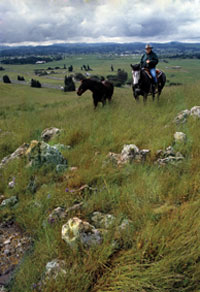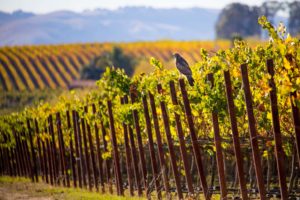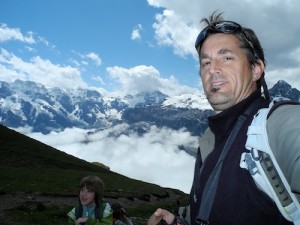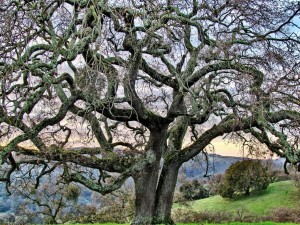Like San Mateo County, Sonoma County has both a private nonprofit land trust and a government body working to protect the landscape, though here the trust came first. The Sonoma Land Trust set up shop in 1976 and acquired some key properties. The pace of preservation picked up in 1990 when county voters established a Sonoma County Agricultural Preservation and Open Space District and funded it with a quarter cent county sales tax. It was a bold step in a county that still had less protected open space, in overall acreage and in acres per citizen, than any other in the region except San Francisco itself.
In order to get moving quickly, the district traveled light for its first 15 years. Following the terms of its initial charter, it has focused its energy on setting aside land; the district is actually restricted from managing property for public use. Similarly, the district has invested most of its money in conservation easements, which make up 80 percent of the acreage protected.
The strategy has yielded rich returns. The map of the Bay Area’s largest county is now speckled with protected areas totaling over 67,000 acres. They include dairy farms and tree farms, crucial greenbelt properties between cities, and grand stretches of near-wild hills. But public access remains at a premium. Into this void has stepped a highly unusual organization called Land Partners Through Stewardship, known by its approximate acronym as LandPaths.
LandPaths arose in 1996 to meet a temporary need. The district had bought McCormick Ranch adjacent to Sugarloaf Ridge State Park near Kenwood for resale to the California Department of Parks and Recreation. But DPR did not have the funds to manage the park addition at the time. Two citizen friends of the district, Caryl Hart and Dee Swanhuyser, joined the landowner, Sandra Lerned Perry, in setting up an independent caretaker, LandPaths.
- Dean Marty on his ranch east of Highway 101 outside Petaluma. Photo by Craig Anderson, LandPaths.
LandPaths took a look at the property—an old cattle ranch at the rugged headwaters of Santa Rosa Creek—and started doing some chores that could not be deferred, like cleaning culverts to prevent washouts into steelhead spawning streams. It also began bringing small groups of citizens to see the future park. Soon it became apparent that these visitors—enchanted by the land—were more than willing to lend a hand in weed control or trail building. Then and there, LandPaths discovered its threefold mission: to get people onto land protected by the district, to teach them about it, and to tap their energy in taking care of it.
In 1999, LandPaths signed a contract with the district to introduce the Sonoma County public to easement properties, subject to agreement with the owners. The first such outing went to the Dean Marty Ranch along Highway 101 between Petaluma and Cotati. An important greenbelt piece, this flowery hillside had been the district’s first acquisition; now Marty was the pioneer in allowing the public to see what its tax dollars were saving.
With the help of grants from the district and other sources, LandPaths today runs some 50 free trips a year to properties under easement, for young and old, for people in boots and people in wheelchairs, for English speakers and Spanish speakers. Director Craig Anderson is especially proud of the district-funded program called In Our Own Backyard, which brings students and teachers from 18 classrooms onto the land. The approach is not so much nature education as nature immersion. Each youngster, for instance, adopts a particular “sit spot,” gives it a name, and returns there several times during the school year to “observe and conserve”—for example pulling exotic plants and nurturing native ones.
A showcase for the joint work of the Open Space District and of LandPaths is the Cooley Ranch west of Cloverdale, where 19,000 acres went under easement in 2001.
The ranch occupies a large part of the watershed of Dry Creek, a Russian River tributary that is dammed just downstream in Lake Sonoma for flood control and water supply. The property is a microcosm of the Coast Ranges: mixed hardwood and conifer forests, some fine old redwoods and valley oaks, serpentine barrens and chaparral, and native animals including river otter, bald eagles in winter, and the occasional wandering Men­docino County bear. There is at least one rare plant species, the beaked tracyina of oak savanna grassland.
To tour the ranch with Crawford Cooley in his memorably battered jeep, up precipitous hill and down shady dale, is to watch an owner beaming with stewardship. Cooley points with pleasure and knowledge to every sign of land health: the burgeoning strips of alder and willow along the creeks, the greening-up of once-denuded hillsides. He also notes problems he wants to correct: a road to be relocated out of a stream, a plantation of ponderosa pine, unsuited to the area, that will be removed in time. He grins at his success in fighting the weeds that wash in from outside ranch boundaries, where a highway crosses the higher reaches of Dry Creek. “I don’t think we have a yellow star thistle anywhere,” he says.
Under the conservation agreement, most of the Cooley Ranch is to be “forever wild,” but intensive agriculture is permitted on a few thousand acres. This will allow the Cooleys to plant grapes on one lofty hilltop where soil, slope, drainage, and climate are just right. It will be one of the highest-elevation vineyards in the county and surely one of the most spectacularly situated. You can imagine a bed and breakfast, an overlook. But nothing of the sort will be here, and only the Cooleys, their workers, and their guests will get the benefit of these views.
That category “guest,” however, is pretty broad. One provision in the Cooley easement authorizes “a nonprofit organization qualified to conduct such activities” to enter the property “no less than six times a year” with guided parties. And enter they do: birders and botanists and trail riders and groups from the schools, including Cloverdale High. Once or twice a year, public campouts are on offer. One LandPaths group disassembled a collapsing shed and neatly stacked the irreplaceable old-growth redwood lumber for re-use in building trails.
Here is a new kind of relationship between citizens and property owners. The landowner gets to be seen, not as a distant and privileged landlord, but as host, caretaker, and storyteller; and the visitor gets to be seen, not as a potential trespasser, but as a guest, a listener, and an occasional helping hand.
At $6 million, the price the Cooleys received for the easement was half its appraised valuation. Nonetheless, this acquisition came in for question in the local press. Did the family really need payment for preserving what it had no plans to develop? Did the public really benefit proportionately? A kind of class resentment came into play, as it often does when land conservation programs write checks to the well-to-do.
Such arguments can resonate in the short term, but die away when you consider the long. Preservation opportunities on this scale are rare and sometimes fleeting. On this land, 105 homes could have been built someday. Neighboring properties in these hills are already fragmenting into rural estates. This one great spread will remain intact—and continue to anchor something even larger. Together with state-run lands around Lake Sonoma, partly open to recreation, the ranch rounds out a 35,000-acre reserve. The protection afforded the county’s water supply alone is probably worth the price paid.
The value for wildlife is also undeniable. As Anderson recalls, “On one tour with Crawford, we saw a bobcat, followed shortly by an adolescent male mountain lion jumping directly across the trail in front of the group. This made the three golden eagles that flew by at eye level later that day seem almost commonplace!”
Unlike the private land trusts, the Sonoma County Agricultural Preservation and Open Space District is looking at a deadline. By 2010, the voters must approve an extension of the sales tax that funds the district. At the same time it will probably seek permission to use some funds for direct management and access. A two-thirds majority is now required, a daunting hurdle. If that kind of support can be assembled—and the odds look pretty good right now—it is thanks partly to LandPaths, which has given so many Sonomans a personal connection with the places their generosity has helped to save.

.jpg)




